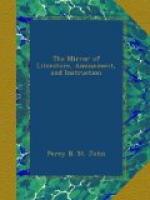POLYNESIAN ISLANDS.
[Illustration: Tucopia.]
[Illustration: Piercy islands]
Mr. George Bennett,[1] whose “Journals” and “Researches” denote him to be a shrewd and ingenious observer, has favoured us with the original sketches of the above cuts. They represent three of the spots that stud the Southern Pacific Ocean. The first beams with lovely luxuriance in its wood-crowned heights; while the second and third rise from the bosom of the sea in frowning sterility amidst the gay ripple that ever and anon laves their sides, and plashes in the brilliancy of the sunbeam.
Tucopia, or Barwell’s Island, has recently been elsewhere described by Mr. Bennett.[2] His sketch includes the S.W. side of the island, and his entertaining description is as follows:
“This small but elevated and wooded island was discovered by the ship Barwell in 1798; it was afterwards (1810) visited by the French navigators, who called it by the native name Tucopia. On the S.W. side of the island is a wooded, picturesque valley, surrounded by lofty mountains, and containing a small but well-inhabited village. Two singularly isolated basaltic rocks, of some elevation, partially bare, but at parts covered by shrubs, rise from about the centre of the valley. When close in, two canoes came off containing several natives, who readily came on board; two of them had been in an English whaler, (which ships occasionally touched at the island for provisions, &c.) and addressed us in tolerable English. They were well formed, muscular men, with fine and expressive features, of the Asiatic race, in colour of a light copper; they wore the hair long, and stained of a light brown colour; they were tattooed only on the breast, which had been executed in a neat vandyked form; the ears, as also the septum narium, were perforated, and in them were worn tortoiseshell rings; around the waist was worn a narrow piece of native cloth (died either of a dark red or yellow colour), or a small narrow mat formed from the bark of a tree, and of fine texture; some of these had neatly-worked dark red borders, apparently done with the fibres of some dyed bark. They rub their bodies with scented cocoa-nut oil as well as turmeric. The canoes were neatly constructed, had outriggers, and much resemble those of Tongatabu; the sails were triangular, and formed of matting. No weapons were observed in the possession of any of the natives; they said they had two muskets, which had been procured in barter from some European ship. We landed on a sandy beach, and were received by a large concourse of natives. We were introduced to a grave old gentleman, who was seated on the ground, recently daubed with turmeric and oil for this ceremony; he was styled the ariki, or chief, of this portion of the island. On an axe, as well as other presents, being laid before him, he (as is usual among the chiefs




